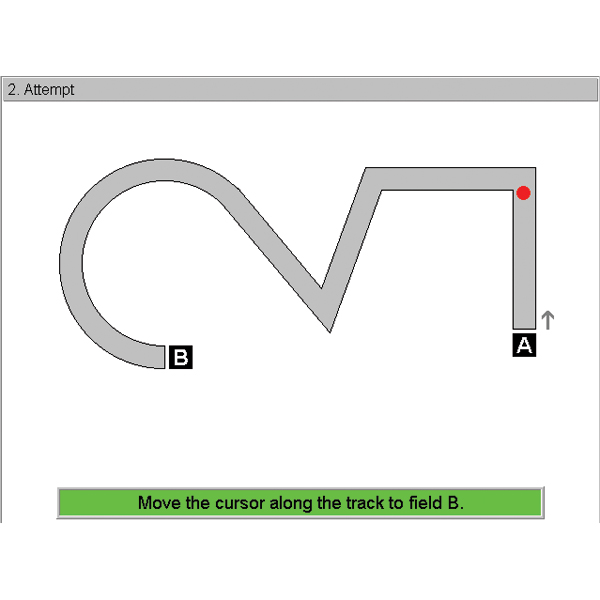
Examination of visual-motor coordination (eye-hand and hand-hand coordination), by moving a dot on a track, through the coordination of both hands.
The test 2HAND reliably assesses the eye to hand and hand to hand coordination. The layout of the track makes a comparison of the coordination performance possible for simple and more demanding tasks.
Two aptitude components lie at the center of the test requirement: sensomotor coordination between eye and hand as well as between both hands. The special difficulty in coordinating both hands lies in the capacity to visually assess left and right deviations between target and actual state and to correct with the hands accordingly. Additionally the capacity to anticipate the course of movement plays an important role.
The task consists in moving an illuminated dot on a preset track, using two control knobs or two joysticks. This track consists of three sections, which make different demands on the coordination of left and right hand. The dot is to be moved from the right to the left.
The following variables are scored: Total mean duration, total mean error duration, percent error duration (calculated as the ratio of total error duration to total duration), and coordination difficulty.
Internal consistency (Cronbach's Alpha) lies between r=0.85 and r=0.97.
The content validity of the test is given since it has logical validity. Karner and Neuwirth (2000) showed that performance in the 2HAND correlates significantly (R=0.50) with an assessment of driving ability. These authors also found that individuals with a score of PR<33 received a significantly worse assessment of their performance in a standardised driving test.
Norm samples of adults are available for all test forms. The sample sizes range from N=151 to N=244. In some cases norms are also available partitioned by gender, age, and education. In addition, some of the following special norms are also available for Forms S1, S2 and S4: traffic-psychological clients and various Swedish norms.
Between 8 and 15 minutes (including instruction and practice phase), depending on test form.
The Schuhfried VTS enables computer-assisted application of a large number of highly diverse psycho-diagnostic tests and measuring procedures. In developing the system much emphasis was placed on transparent structure and largely uniform design. It is therefore simple to operate and easy to understand and does not require any special computer skills.
The VTS basic module is required for administration of any of the available tests.
The Schuhfried VTS supports the administration of both single tests and test batteries. Many of the single tests are available in different test versions. These test versions may differ, for example, in terms of test duration or difficulty or may be parallel forms. They are characterized by different parameters reflecting specific test requirements. They have been designed for administration to a specific population (e.g. psychiatric patients, children, etc.) or for special measuring purposes (e.g. repeated measurements). Test batteries are compiled from the available single tests and test versions.
The universal panel allows for user-friendly data input and can be used for many different tests. The test selected determines if the panel is needed. Consult the test's description to see if this panel is required.
The Schuhfried VTS enables computer-assisted application of a large number of highly diverse psycho-diagnostic tests and measuring procedures. In developing the system much emphasis was placed on transparent structure and largely uniform design. It is therefore simple to operate and easy to understand and does not require any special computer skills. This VTS basic module is required for administration of any of the available tests.
